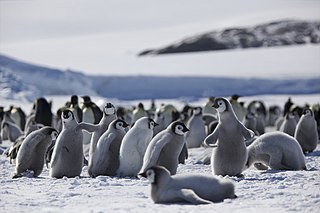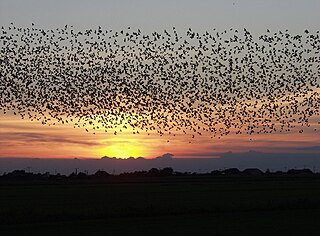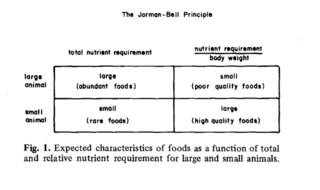The digestive rate model (DRM) [1] (of foraging) is related to optimal foraging theory in that the model describes the diet selection that animals should perform in order to maximize the energy (or nutrients) available to them. It differs from the main body of Optimal Foraging Theory in stating that animals can select food in order to make optimal use of their digestive tract (maximize digestion rate) rather than the maximization of the food ingestion rate, which is the base of Optimal foraging theory.

Foraging is searching for wild food resources. It affects an animal's fitness because it plays an important role in an animal's ability to survive and reproduce. Foraging theory is a branch of behavioral ecology that studies the foraging behavior of animals in response to the environment where the animal lives.

Optimal foraging theory (OFT) is a behavioral ecology model that helps predict how an animal behaves when searching for food. Although obtaining food provides the animal with energy, searching for and capturing the food require both energy and time. To maximize fitness, an animal adopts a foraging strategy that provides the most benefit (energy) for the lowest cost, maximizing the net energy gained. OFT helps predict the best strategy that an animal can use to achieve this goal.
A nutrient is a substance used by an organism to survive, grow, and reproduce. The requirement for dietary nutrient intake applies to animals, plants, fungi, and protists. Nutrients can be incorporated into cells for metabolic purposes or excreted by cells to create non-cellular structures, such as hair, scales, feathers, or exoskeletons. Some nutrients can be metabolically converted to smaller molecules in the process of releasing energy, such as for carbohydrates, lipids, proteins, and fermentation products, leading to end-products of water and carbon dioxide. All organisms require water. Essential nutrients for animals are the energy sources, some of the amino acids that are combined to create proteins, a subset of fatty acids, vitamins and certain minerals. Plants require more diverse minerals absorbed through roots, plus carbon dioxide and oxygen absorbed through leaves. Fungi live on dead or living organic matter and meet nutrient needs from their host.
The basic tenet of the DRM is that the intake of energy by an animal passes through two consecutive processes, food ingestion or foraging, and food digestion. Optimal foraging theory describes the diet selection if the food ingestion rate is the limiting factor. The DRM describes diet selection and foraging behavior if digestion is the rate limiting process. Food can consist of varying fractions of largely indigestible parts such as fibre in plant material, shells of molluscs or insect chitin, which can be thought of as 'rate limiting' for the digestion process or somewhat more intuitively as 'bulk' that takes up capacity that can be spent better for material with a higher digestibility.
Ingestion is the consumption of a substance by an organism. In animals, it normally accomplished by taking in the substance through the mouth into the gastrointestinal tract, such as through eating or drinking. In single-celled organisms, ingestion can take place through taking the substance through the cell membrane.
A limiting factor is a variable of a system that, if subject to a small change, causes a non-negligible change in an output or other measure of the system. A factor not limiting over a certain domain of starting conditions may yet be limiting over another domain of starting conditions, including that of the factor.

Chitin (C8H13O5N)n ( KY-tin), a long-chain polymer of N-acetylglucosamine, is a derivative of glucose. It is a primary component of cell walls in fungi, the exoskeletons of arthropods, such as crustaceans and insects, the radulae of molluscs, cephalopod beaks, and the scales of fish and lissamphibians. The structure of chitin is comparable to another polysaccharide—cellulose, forming crystalline nanofibrils or whiskers. In terms of function, it may be compared to the protein keratin. Chitin has proved useful for several medicinal, industrial and biotechnological purposes.
The original description of the model positioned the DRM as an alternative to the contingency model (CM) of optimal foraging and pointed out that some of the predictions of the DRM provide a better match than did the CM with observed diet choice and behavior of e.g. herbivores. The DRM went largely unnoticed, but a recent paper by Van Gils [2] describes how red knots Calidris canutus forage based on digestive bottlenecks and confirmed their foraging according to the DRM rather than the CM model of optimal foraging. The case is particularly interesting as a major difference in individual foraging behavior is related to a large intraspecific difference in the digestive tract of the knots.






